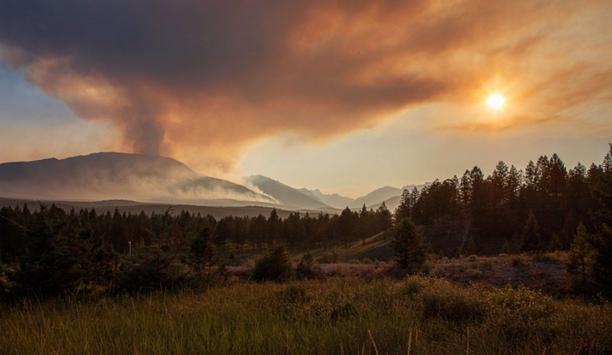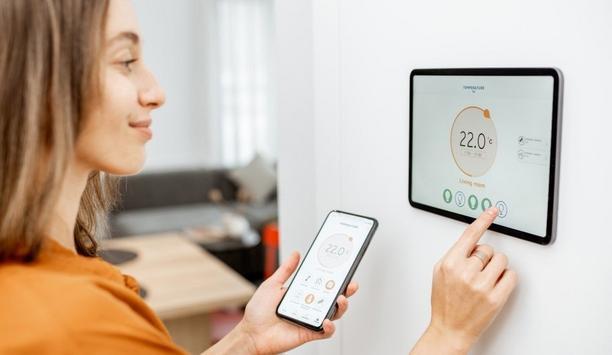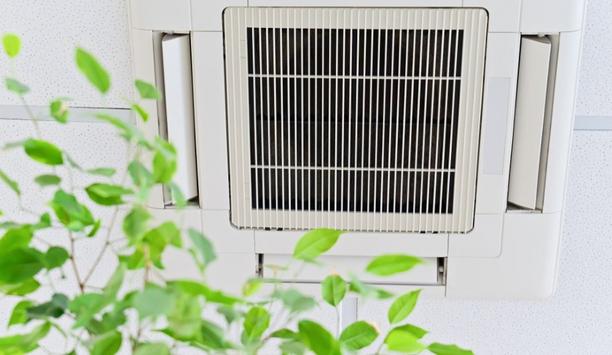Technology & Trends - Indoor Air Quality (IAQ)
Devastating wildfires sweep across the US each year, leaving a trail of destruction in their wake. Aside from the immediate damage that fire causes to property and land, the additional impact that wildfire smoke has on air quality creates a serious but often overlooked threat to human health. This threat from poor air quality includes people in the workplace. IAQ management As wildfires increase in frequency and intensity, facility managers must be proactive to protect occupants inside...
Advanced heating, ventilation, air-conditioning, and refrigeration (HVACR) systems have always been essential to healthcare. However, the need for clean, fresh air at the right temperature and humidity within clinical settings has never been made clearer during the COVID-19 pandemic. It illustrated the importance of effective HVACR systems in healthcare due to their ability to improve air quality, patient outcomes, and infection control measures. The need for change Many current...
Using air conditioners and electric fans to stay cool accounts for nearly 20% of the total electricity used in buildings around the world, according to a report from the International Energy Agency. hybrid work model As a unique mix of key factors, such as the adoption of the hybrid work model and escalating heatwaves in certain regions of the United States keep people indoors for longer periods, this 20% share represents an increasingly costly line item on household budgets. Those within th...
Today’s HVAC contractors are acutely aware that they need visibility on the internet and in their community if they want the phones to ring with requests for new business. As a result, HVAC company leaders have become savvy about marketing and advertising and know that search engine optimization, direct mail flyers, and flashy truck wraps attract attention. Public relations But what they don’t stop to think about is that their competitors likely have a very similar marketing strat...
Patented new filtration technology proved it can upgrade AC units and Air Curtains to become highly effective Air Purifiers. Background and problem AC Split Units and Air Curtains employ coarse dust filters that are normally installed within the housing at the air return vent to allow for frequent filter cleaning. While this vital activity is generally performed on a regular basis in professional settings, it may be overlooked in home settings, leading to the clogging of these filters. This de...
Coastal and tropical areas present their own unique challenges for business and residential HVAC units. For these machines, which we use to create comfortable, safe air for occupants, corrosion is enemy number one in high moisture environments. Due to the high level of moisture and salts in the air along the coast, HVAC solutions are more susceptible to corrosion. These salts can negatively impact unprotected coil fins and metal surfaces, causing them to corrode, which can ultimately lead to s...
Poor indoor air quality (IAQ) has been a longstanding problem within educational institutions, where it has been known to affect productivity and performance, as well as mental and physical health. And it’s not just the pupils at risk, with studies finding that this deleterious phenomenon can also compromise teaching performance and delivery, which inevitably affects the quality of the information received. CO2 concentrations This has recently been evidenced in a study conducted by the U...
Achieving carbon neutrality has, once more, become a business priority. Whilst COVID-19 distracted attention away from the drive towards Net Zero, green issues are once more back on the agenda and rising to the top of it. Building specifications The built environment accounts for around 28-40% of global emissions, so there is a collective ambition to start specifying buildings with as low a carbon footprint as possible. This is particularly true of commercial office spaces where operational...
Ventilation systems have never been more important as we battle against an ever-evolving pandemic, and crucially, they must be installed correctly to deliver good indoor air quality for years to come. David Millward, Group Product Manager at Elta Group, explains the practical considerations needed for contractors in charge of installing them. Good indoor air quality (IAQ) With a pandemic that has been raging for going on two years, there has never been a time where good indoor air quality (IAQ...
With COP26 behind us, the words ‘Net Zero’ still hangs heavy in the air as we look to make the most of the momentum gained by the summit. On the face of it, it’s a daunting task. However, like so many challenges in life, it becomes considerably more manageable when broken down into smaller steps. It’s now a widely accepted fact that lighting, heating, and cooling operating emissions account for a significant proportion (28%) of all carbon emissions emitted by building an...
Indoor air quality (IAQ) has never been closer to the forefront of the public mind. After all, the COVID-19 pandemic is still ongoing. The government’s scientific advisors have warned that, during the coming winter, daily hospitalizations could plausibly reach heights of 7,000 per day. And, of course, we are all thoroughly aware at this point that COVID is an airborne virus and, as such, spreads very effectively indoors – a fact which many people will have reflected on as they...
AI (Artificial Intelligence) is a smart buildings’ biggest ally. Without it, a building could hardly be classed as smart. For building owners and managers, AI is imperative to create a secure and comfortable experience for their occupants every day. What a building platform should do is gather data from various sources from the building management system and other smart technologies, to gather it all in one place. The data should then be fed into a flexible, scalable cloud-based platform...
Even though the COVID-19 pandemic is seemingly drawing to a close, living, working and learning at home is set to continue. Under this new normal, home electricity use is expected to double by 2050. Simultaneously, as climate change devastates communities around the world, we are faced with a moral and economic obligation to cut CO2 emissions from houses. Our goal is to build Net Zero houses and we can't get there fast enough. Fossil fuels use in heating systems Many countries continue to rely...
Seasonal transitions are the perfect time to take inventory and inspect a building’s various systems. We’ve been reminded for years that when we set our clocks back, we should also replace the batteries in our smoke detectors. The same thought process can be applied in support of seasonal preventative maintenance for a building’s HVAC system. Now that the cooling season has passed for a large part of the country, it is time to ensure that HVAC systems have been shut down prope...
I am writing this the day after the Autumn Spending Review, which among many measures, included a huge focus on how the Government wants to ‘level up the country’, creating a new post-pandemic economy, with higher wages and higher skills. Part of this is the £500 million ‘Multiply’ scheme, which aims to increase numeracy and basic mathematics for adults in the United Kingdom via in person tutoring, digital training and flexible courses. Lack of basic skills to acce...
The development of digital technologies in the Heating, Ventilation and Air Conditioning (HVAC) sector has been transformational for the industry, as well as for those who run HVAC systems. While the electrification and digitalization of machines, and assets has made a lot of operations simpler, it has also meant that the collection of machine data has never been more critical. Given that engineers can now view lots of different metrics on a single screen, including things like heating control...
It is now more common to read about cases of Legionnaires’ disease in the media than ever before, with outbreaks regularly being reported in cities around the world, all the time. Many of these cases are attributed to contamination of domestic systems, showers and spas, but some are the result of operating cooling towers. While this problem is not new, with the first reported case in Philadelphia, in 1976, the United Kingdom (UK) has been at the forefront in leading the battle with Legionn...
At the moment, it seems as though a day rarely goes by without low-carbon heating hitting the headlines. Whether it is reports of ‘revamping’ the Clean Heat Grant, to include a ‘boiler scrappage’ scheme, which may offer home owners up to £7000 to make the switch to a low-carbon alternative, to speculation that the Prime Minister is under pressure to push back the 2035 ban on gas boilers, the debate on how and when the low-carbon heating revolution will happen is ong...
Indoor air quality (IAQ) has become an area of emphasis among those in the HVAC industry and on a national level. Homes, offices, schools, and everything in between are being reevaluated with the ambition of having the best IAQ possible. Maintaining a high level of air quality is an important factor in encouraging a cleaner indoor breathing environment, which can lead to the better overall health and well-being of our families and communities. Clean air is especially important now with more wav...
In today’s world, we spend almost 90 per cent of our time indoors, in our workplaces, leisure areas and our homes. It is no secret that the built environment has been relatively slow in its embrace of information technology and automation. According to KPMG’s ‘Building a Technology Advantage’ report, fewer than 20 percent of construction and engineering executives, and major-project owners said they are re-thinking their business models, so as to incorporate new technolo...
A quick glance at official COVID-19 mitigation guidance reveals that it promotes increased ventilation air change rates, as the most effective way to keep people safe. Sounds easy, doesn’t it? Just open a window or turn up your ventilation system, if you have one. The fact is, however, that the vast majority of domestic properties in Britain does not have a mechanical ventilation system and rely on natural means for background ventilation, including windows, trickle vents or air bricks. In...
The energy transition is upon us and we are shifting today’s energy use to low and zero carbon sources. The way in which we heat and provide hot water to our homes and businesses will change, and we are developing technologies that will support this transition. A bold and pragmatic policy framework will encourage investment and drive change. BEIS Hydrogen Strategy We, therefore, welcome the publication of the Hydrogen Strategy from the Department for Business, Energy & Industrial Str...
Most people spend about 90 percent of their time indoors. For home owners, indoor environmental quality (IEQ) is the most meaningful differentiator between ‘high-performance’ and ‘code-built’ homes. Indoor environmental quality IEQ describes how well the indoor environment promotes occupant comfort and health. The components of IEQ include thermal comfort, indoor air quality (IAQ), sound and lighting. Requirements for optimal IEQ vary per occupant and household, d...
As our urban centers grow, so does our demand for key resources, such as energy. Currently, cities are accountable for over 60% of resource use and an estimated 70% of global carbon emissions. In the Middle East particularly, countries have experienced unprecedented population growth, increased economic activity and consequently, increases in energy consumption. Integration of sustainable systems Fortunately, industry leaders and governments are placing sustainability at the heart of regional...
Utilizing the latest in building connectivity, facility operators can uncover a wealth of data in their systems. The next step comes by leveraging that data with artificial intelligence (AI) and a suite of connected solutions. Data is analyzed to determine actionable items and achieve data-based outcomes that improve efficiencies, allow operators to meet budget goals, hit sustainability targets and deliver on occupants’ expectations. To make those high-level outcomes happen, collecting a...
Now, more than ever, Indoor Air Quality (IAQ) is a major focus concerning the health and safety of students and faculty within the nation’s schools. As they prepare their facilities for a return to in-person learning, school officials are being forced to get an education in the most effective ventilation solutions to help prevent the spread of COVID-19 and other infections. Even without factoring in airborne threats like COVID-19, poor IAQ can negatively affect the health and learning of...
With ongoing efforts from governments across the globe to reduce carbon emissions and with an ever greater focus on sustainability, it is vital that the HVAC sector does its part in becoming more environmentally conscious. And, while there have been steps to become more sustainable, there is a huge amount that still needs to be done to make sure that many of the targets that have been set are attainable. In buildings, both large and small, industrial heating accounts for roughly two thirds of i...
As we continue to grapple with COVID two very clear future objectives have emerged: The need for safer and healthier indoor environments to protect against SARS-CoV-2 and other infectious microbial. Acceleration of UK’s net zero by 2050 plan - 78% reduction by 2035 compared to 1990 levels. Last week a group of world-renowned scientists published a paper entitled ‘A paradigm shift to combat indoor respiratory infection’ affirming the need for improved building ventilation...
The education field was faced with multiple challenges this past year. Not only did the COVID-19 pandemic bring the necessity of online learning, but it has also brought up necessary changes to physical schools and universities, when reopening time arrives. The health and safety of students, staff, and faculty has become a priority for directors of school operations, who have been working to properly adapt school facilities to this new reality we are facing. Ensuring health and safety of studen...
Do HVAC systems help with the spread of COVID-19? No one is entirely sure, but it seems very likely. Especially in the case of enclosed indoor spaces. As soon as the COVID-19 pandemic began, fingers pointed to air-conditioning systems as culprits, and scientists now believe a super-spreader event traced back to a restaurant in Guangzhou, in China, which could have started with an asymptomatic person who just happened to cough close to an HVAC fan. Scientists also believe something similar happe...
Browse expert commentaries
Related videos
Introduction | Decarbonization Explained | Danfoss
Munters LCX Liquid-To-Liquid Coolant Distribution Units
Rheem Water Heating Celebrates 2024
From A To L: Your A2L Transition Guide
DownloadLeveraging Radiant And Hydronics To Help Achieve Decarbonization Goals
DownloadSealed Connectors In Harsh Environments
DownloadPowering And Cooling Next Generation Data Centers
DownloadDebunking Myths To Promote A Bright Future For Heat Pumps
Download





































